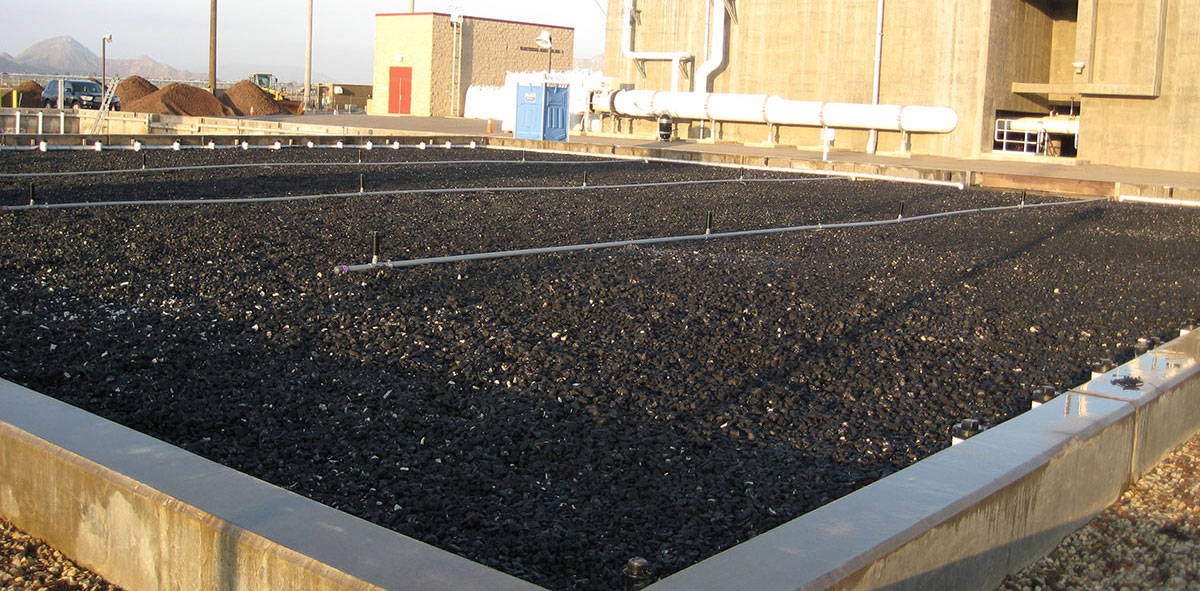
Structural and physicochemical properties of GES Biotek media boost efficiency.
Biofilters rely on microbial communities to degrade airborne pollutants, with media serving as the foundational support for biofilm formation. Traditional organic media (e.g., wood chips, compost) suffer from degradation and compaction over time, limiting long-term efficiency.
In contrast, inorganic substrates such as Cell-Max™ and Enhanced Cell-Max™ offer enhanced durability, high porosity, and improved moisture management, addressing key limitations of organic media. This review explores the role of these media in optimizing biofilter performance based on key operational parameters.
Media Structure and Surface Characteristics
The Cell-Max™ and Enhanced Cell-Max™ substrates are manufactured from post-consumer recycled glass, forming a rigid, lightweight, and highly porous matrix. The engineered open-cell structure:
- Increases surface area for microbial attachment and biofilm development.
- Enhances gas exchange and minimizes airflow obstruction.
- Resists degradation, ensuring long-term biofilter stability.
The Enhanced Cell-Max™ variant is further modified with proprietary nutrient coatings, adsorbents, and mineral additives, fostering microbial proliferation, and accelerating pollutant biodegradation.
Airflow Resistance and Pressure Drop
Biofilter efficiency is often constrained by pressure drop, which affects energy consumption and gas residence time. Efficient biofilter operation requires low airflow resistance to minimize energy consumption while ensuring adequate oxygen transfer to microbial communities. Over time, biomass accumulation may increase resistance.
Compared to organic biofilter media, which often suffer from compaction and clogging, Cell-Max™ and Enhanced Cell-Max™ maintain stable porosity and airflow distribution, excessive backpressure from compaction and clogging may compromise performance. Over extended operational periods, moderate biofilm accumulation is expected to increase resistance slightly, though still within acceptable limits for sustainable operation.
Microbial Colonization and Pollutant Biodegradation
The efficacy of biofilters depends on the establishment of diverse and active microbial consortia capable of degrading target pollutants. Studies have demonstrated that Enhanced Cell-Max™, owing to its nutrient-rich formulation, fosters rapid microbial colonization compared to uncoated inorganic substrates. This accelerated biofilm formation leads to:
- Higher degradation rates of hydrogen sulfide (H2S), ammonia (NH3), and VOCs.
- Enhanced metabolic activity, reducing odor-causing compounds to parts-per-billion (ppb) levels.
- Improved resilience against environmental fluctuations (e.g., humidity and temperature variations).
Further research is being done to quantify specific microbial community shifts over time and their correlation with pollutant removal efficiencies.
Moisture Management and Hydrodynamic Stability
Optimal moisture balance is critical for microbial viability in biofilters. Excessive drying leads to microbial dormancy, while oversaturation restricts oxygen diffusion, promoting anaerobic conditions. The open-cell design of Cell-Max™ and Enhanced Cell-Max™ enables:
- Efficient capillary action, retaining sufficient moisture without clogging.
- Consistent humidity control, reducing performance fluctuations.
- Minimal waterlogging, mitigating anaerobic biofilm formation.
Compared to traditional organic media, these GES substrates demonstrate superior moisture retention with minimal structural compaction, contributing to long-term hydrodynamic stability.
Longevity and Sustainability
A major advantage of Cell-Max™ and Enhanced Cell-Max™ is their extended lifespan, exceeding 20+ years under typical operating conditions. Unlike organic counterparts that undergo microbial degradation and require frequent replacement, these glass-based materials:
- Maintain structural integrity, preventing compaction and channeling.
- Reduce maintenance costs, minimizing media replenishment frequency.
- Utilize recycled materials, aligning with sustainable waste management practices.
Conclusion and Research Prospects
The use of Cell-Max™ and Enhanced Cell-Max™ in biofilters offers distinct advantages in terms of microbial support, airflow efficiency, moisture regulation, and durability. These insights will contribute to the optimization of next-generation biofiltration systems, reinforcing the role of engineered media in sustainable air pollution control technologies.